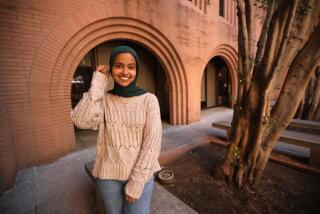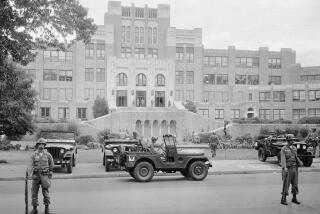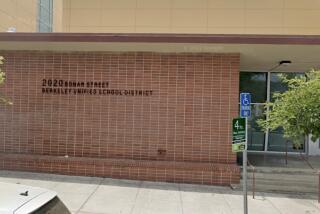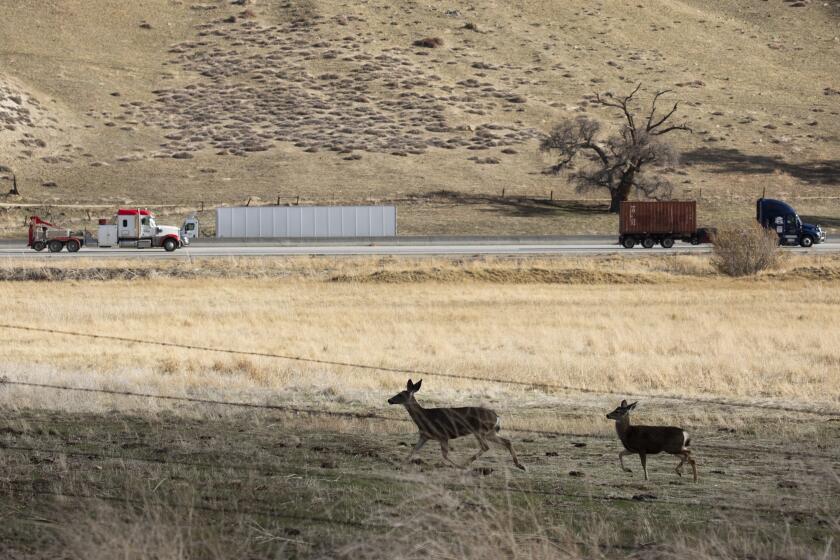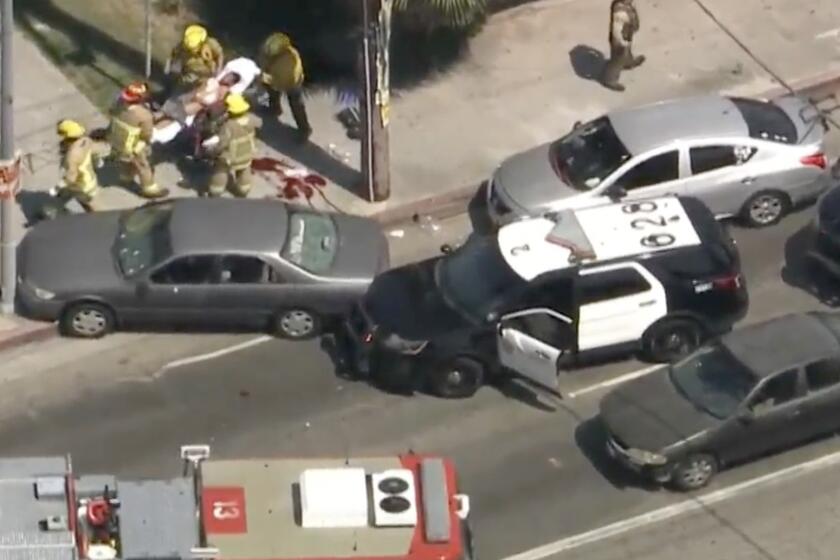In the age of Trump, there’s a fine line between racism and free speech. Even at high school football games
Maybe in another time, the scene at an Orange County high school football game might have felt different: the home team fans dressed in red, white and blue chanting, “USA!” “USA!,” after a touchdown.
But this is an age of polarization from President Trump on down, of us versus them, of viral accounts of racist rhetoric and bullying in schools — and the home team’s campus is mostly white, the visiting team’s almost entirely Latino.
For the record:
4:10 p.m. Sept. 11, 2018An earlier version of this story misidentified an initiative at Harvard as the Making Care Common project. It is the Making Caring Common Project.
The Southern Poverty Law Center has collected disturbing anecdotes nationwide: white students in Arizona raising a Confederate flag during the pledge of allegiance at an assembly, a Georgia high school teacher reporting students who repeated an offensive phrase about women, and joked “about Latino students ‘going back to Mexico.’”
In an analysis of 472 hate and bias incidents in K-12 schools over the last three years, Education Week and ProPublica found that “most incidents that took place in schools between January 2015 and December 2017 targeted black and Latino students, as well as those who are Jewish or Muslim.”
Some of what occurred Friday at the game between Aliso Niguel and Santa Ana high schools remains in dispute. But what happened there — and the furor that followed — highlights the current often-barbed debate over what qualifies as patriotism, what constitutes racial insensitivity or racism and what qualifies as protected free speech.
Aliso Niguel students also displayed one or more signs that said, “We like White.” The school said that sign takes on an unintended tinge out of context — that there were also signs that said “We like Red” and “We like Blue,” all meant to celebrate the flag. Another sign — verified in a photo — is less ambiguous. It read, “We gonna TRUMP ya.”
In a Monday note to parents, Aliso Niguel’s principal, Deni Christensen, said administrators were in the process of removing those signs before Santa Ana High Principal Jeffrey Bishop complained to her and threatened to take his team off the field.
Christensen said that her staff also removed a pro-Obama sign as well as a banner — unfurled later — that said “Trump 2020.” She said administrators also asked students to stop the “USA!” chants.
There were reports that students also chanted “Build the wall” and held up a sign with that message — but those reports are strongly disputed by some in attendance.
What students say and how they say it — in a school and as citizens participating in a democracy — have always been a subject of debate in civics classes and in the shaping of school rules. But students’ speech and actions have assumed far greater prominence in such times of discord as the civil rights era and during the Vietnam War. These days, as political discourse has grown increasingly tribal, educators are trying to emphasize teachable moments when they can and to figure out the best ways to perform triage when necessary.
“You have to teach students to understand. … Yes, they have the right to free speech, but they don’t have the right to degrade other people,” said Rick Weissbourd, a Harvard education professor and faculty director of Harvard’s Making Caring Common project, which leads projects to try to promote kindness over bullying.
A student has a legal right to wear a T-shirt supporting President Trump, and a chant of “USA!” wouldn’t raise eyebrows at a World Cup soccer game. But context matters, USC law professor Jody Armour said.
The chant easily can become “weaponizing patriotism,” Armour said. “You’re using it as a way of insinuating that the people on the other team are not really one of us. ... They’re not really American.”
Numerous experts have expressed concern that Trump’s words and policies could inspire bullying or harassment. The Washington Post reported on a middle school in Michigan where students began chanting “Build the wall!” during lunch.
But what children say and what they fully understand may be different, said Sue Swearer, a University of Nebraska-Lincoln educational psychology professor.
Sometimes kids mimic things ”because they heard their parents saying it, or they heard it on the news,” she said.
In a 2017 nationwide survey, about a quarter of teachers said they were observing more contentious relationships between different student groups than they had in the past. In some cases, teachers reported that the students were mirroring national political rhetoric, UCLA education professor John Rogers said.
Though the survey did not ask which groups of students were most often the aggressors, in follow-up interviews and in an open-ended question on the survey, teachers often reported “white students taking action against nonwhite students,” Rogers said.
People associated with Aliso Niguel insisted nothing of that sort happened Friday. The celebration of the flag’s colors, they said, was meant to commemorate the American heroes from the terrorist attacks of September 11, 2001.
“On a night that’s themed in honor of 9/11 and when the student body has encouraged everybody to dress patriotic, I don’t have a problem with USA chants,” said Jonny Wolf, a parent of two biracial football players, whose wife is Latina. “If the other team felt alienated or upset by that, I would feel awful. They are just as much a part of the USA. The motivation was not to insult them at all.”
Several Aliso Niguel parents accused the Santa Ana principal of being reckless by posting his views on social media, which they worried could result in students being targeted or trolled. The two schools should have worked quietly together to resolve problems, they said.
The view from the community of Santa Ana High, which is almost 99% Latino, was different.
Many Santa Ana students worry about possible deportations, Principal Bishop said. What may sound patriotic to others may sound threatening to them, he said.
Still, he said, it would be a mistake to stereotype either school.
“It’s never acceptable,” he said, “to paint a community with a broad brush.”
Twitter: @howardblume
Twitter: @Sonali_Kohli
More to Read
Start your day right
Sign up for Essential California for news, features and recommendations from the L.A. Times and beyond in your inbox six days a week.
You may occasionally receive promotional content from the Los Angeles Times.
